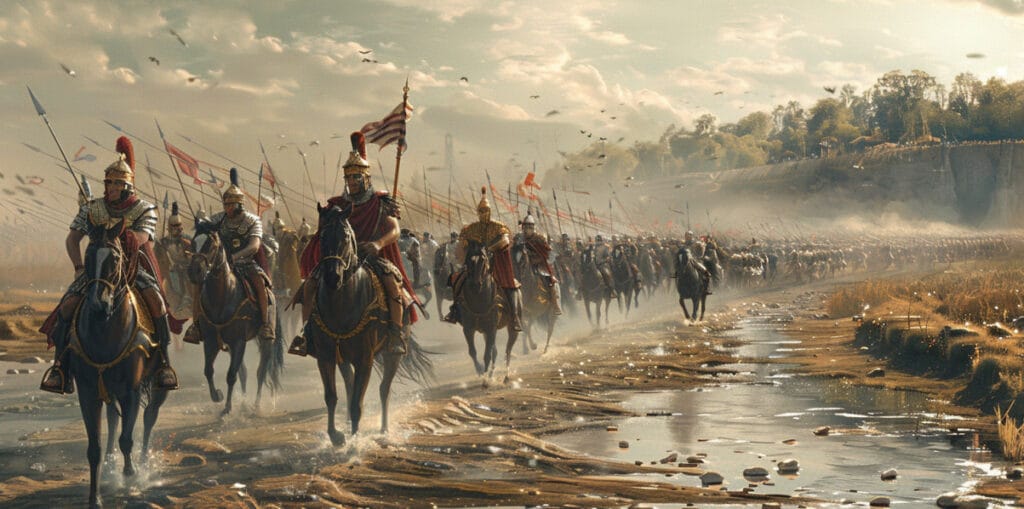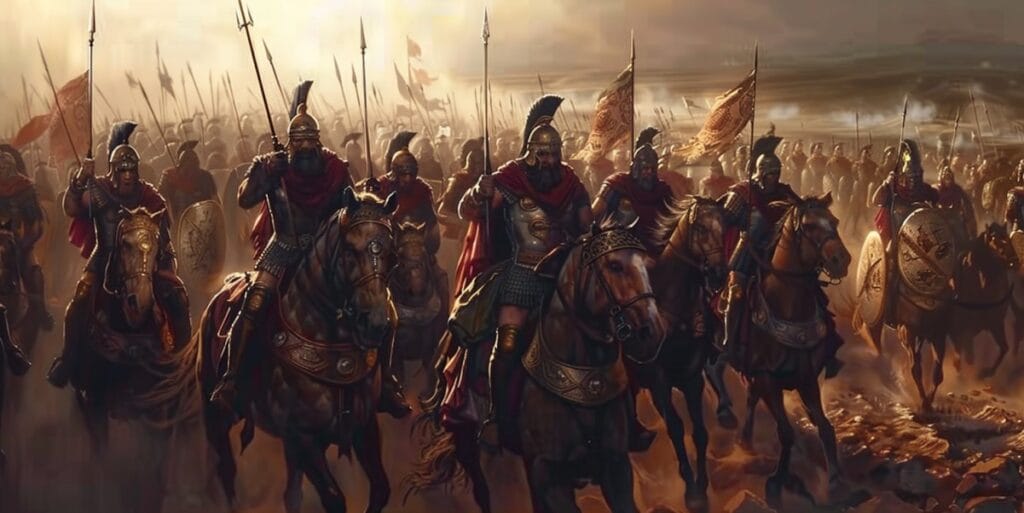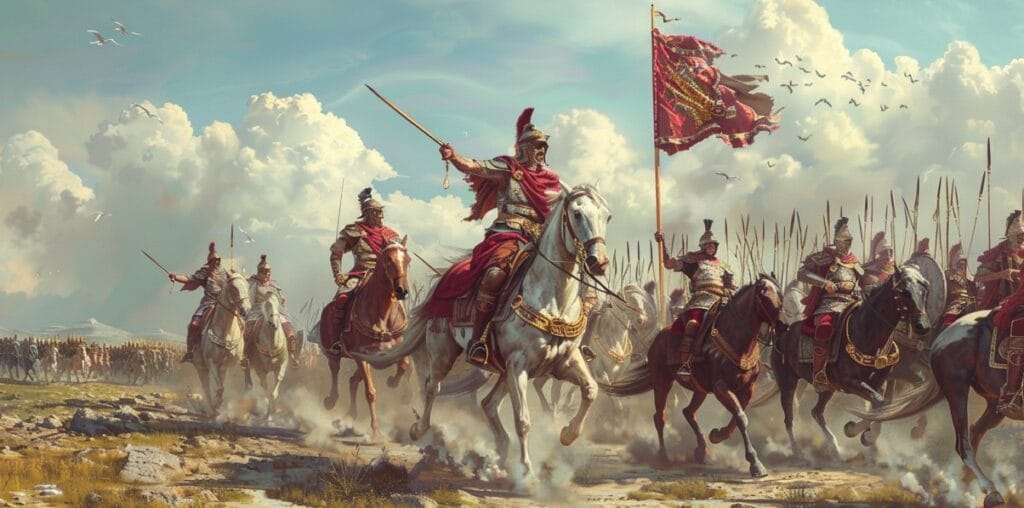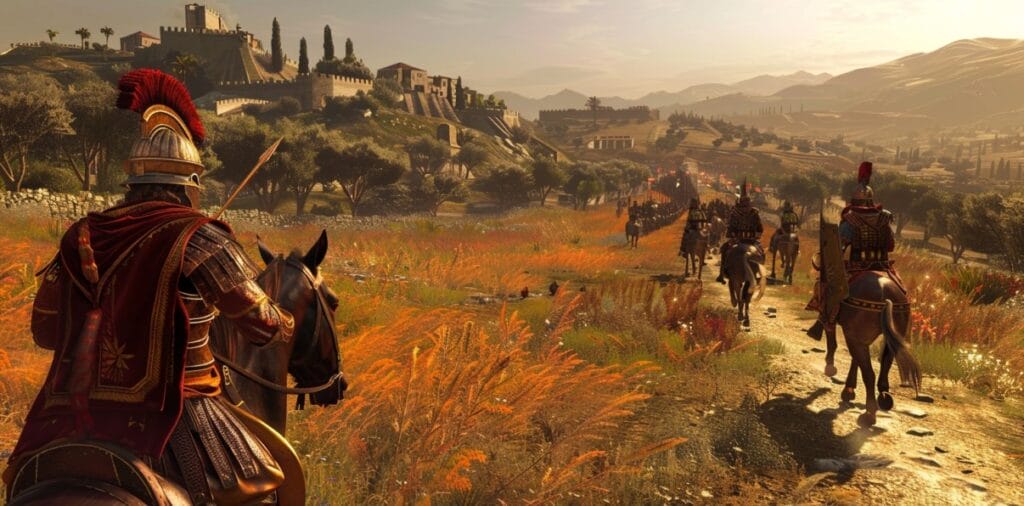AD 272/273
by ‘Emperor Aurelianus’
Background to the Conflict

The conflict between Zenobia of Palmyra and Aurelian took place for the most part in 272ad, in the second year of the reign of Aurelian. The cause of the conflict is the open rebellion against Roman authority of the Palmyrenes and their attempt to set up a semi-independent monarchy.
In the year 267ad, Zenobia was the wife of the leader of Palmyra, Odenathus, who was at that time recognized as a semi-independent ruler of Palmyra by the Emperor Gallienus in recognition of Odenathus’ victories over the Persian monarch Sapor, who defeated and murdered Gallienuis’ father, the Emperor Valerian. Ostensibly Odenathus ruled Palymra as a regent of Rome and the province was considered part of the Roman Empire. In truth however, Odenathus ruled Palymra independently. For Gallienus, Odenathus provided a buffer against further Persian incursions against Roman territories and his recognition of Odenathus was partly a matter of putting an official stamp on something about which he was powerless to change; the Roman Empire in these times was beset by enemies both foreign and domestic which greatly weakened the authority of Gallienus; his personal weaknesses further compounded these problems for Rome. Thus did matters stand in 267ad.
In that year, Odenathus, along with his eldest son and heir apparent, were murdered. There is much speculation as to who, if anyone, was to blame. Gibbons’ account relates simply that it was an arguement of pride with his nephew in a hunting expedition; others speculate that he was the victim of a plot hatched by Gallienus. This appears unlikely; Odenathus was useful to Gallienus as well as the avenger of his father’s death. Others speculate Zenobia was behind this as it was convenient that Odenathus as well as his heir died; ultimately no real answer may ever be found. Nevertheless, the new heir to the throne, Vaballathus, was the son of Zenobia and Odenathus; it was determined after the death of Odenathus that Zenobia would rule as regent in the name of her infant son.

That Zenobia was seen as fit to rule is a tribute to a woman who, by all accounts, was more than capable of the task. Gibbons’ account of her goes describes a woman of extreme beauty, well educated and heavily influenced by Greek thought, one who enjoyed the company of her husband in the hunt.. and was not less than his equal. Gibbons describes her marching with the troops and in one occasion leading them into battle personally and leading them well. She is also described as an able administrator. Aurelian, fearing the scorn he would receive by campaigning against a woman, said “The Roman people,” says Aurelian, in an original letter, “speak with contempt of the war which I am waging against a woman. They are ignorant both of the character and of the power of Zenobia. It is impossible to enumerate her warlike preparations, of stones, of arrows, and of every species of missile weapons. The fear of punishment has armed her with a desperate courage”.
In 268ad, the Emperor Gallienus was murdered by a revolt of his own troops as he was besieging a challenger to his throne. It was resolved by the troops to name Claudius emperor; Claudius however died a mere 16 months later of the plague. Claudius is the general credited with the titanic Roman victory at Niassus (though Gallienus was still emperor) and earned the name Claudius Gothicus from the Senate for another gigantic victory over the Goths soon after taking the purple.
In 269ad, during the reign of Claudius was the beginning of Zenobia’s open rebellion against Rome. Zenobia wished to remain in her husband’s position, and with the recognition Rome gave Odenathus, and it appears that Claudius refused to recognize Zenobia’s authority in Palmyra, thus setting up an inevitable clash. In 269/270 Zenobia, fearing Claudius would attack and hoping to force him into a compromise, attacked first and took first Antioch and then continued to march on to Egypt, defeating the capable Roman prefect Tenagio Probus in a series of battles and taking control of Egypt. Apparently Zenobia believed while Claudius was busy with the Goths, taking Egypt might force him into some form of recognition as Egypt was the main source of grain for Rome at this time.
In 270ad, Claudius died of the plague at Sirmuim and shortly thereafter (Quintillus quitly committed suicide after declaring himself Emperor) Aurelian was recognized by the army and senate as Emperor. Almost immediately Aurelian was besieged by barbarian attacks; in 271ad the Italian city Placentia was sacked by the Alemanni tribe. He eventually recovered from this defeat and defeated the Alemanni piecemeal after this. By late in 271ad he appears to have stabilized the situation with the various barbarian invasions. There was also a revolt of mint workers in Rome itself, which was put down in a bloody fashion. In the East, Aurelian..like Claudius.. refused to recognize Zenobia. There were, however, coins minted in Palmyrene-controlled Antioch with both Valaballus and Aurelian, with Aurelian as Caesar, on them; this appears to be an attempt on the part of Zenobia to appease Aurelian. Aurelian, as did Claudius before him, always desired to re-unite the parts of the Empire that at the time has fallen away from the Empire; Zenobia’s Palmyra and the Gallic Empire founded by Postumus and later ruled by his son Tetricus. Having taken care of the barbarians and restored order in Rome as well as beginning the Aurelian Wall, he set himself and his Army to deal with the insurgent Empires.

The Campaign in the East
In 271ad, upon hearing rumors that Aurelian would march on Palmyra, Zenobia took the preventative step of marching into Asia Minor provinces of Cappadocia and Cilicia and trying to establish local support before Aurelian could do so, thus making him having to advance through hostile rather than friendly territory on the way.
Aurelian began the campaign and advanced into Asia Minor beginning in 272ad. He dispatched Probus by sea to reclaim Egypt while Aurelian himself led the main Roman army into Asia Minor towards Syria. The first recorded action appears to place at Tyana in Cappadocia, where the city was betrayed to Aurelian. It was here that Aurelian spared the populace and declared that all who cities that surrendered to him would be spared. Aurelian next advanced towards Antioch and it was here that Zenobia resolved to give battle. Outside of the village of Immae, just east of Antioch, the Palmyrene forces led by the Egyptian Zabdas gathered to give battle. The Battle of Immae began with a Palmyrene heavy cavalry, the ‘cataphractii’, charging, which appears to have broken the lighter Roman cavalry formations, which fell back in apparent disorder and into a marshy area after a long flight.. where the Roman infantry was waiting and routed the now tired Palmyrene horse. After this the Palmyrenes appear to have determined to make a stand in the suburb of Daphne where the Palmyrenes held a hill. The Roman infantry advanced in a testudo formation and cut apart the Palmyrenes. From here Antioch surrendered to Aurelian and what remained of the Palmyrene Army retreated towards Emesa, a town on the main road towards Palmyra.
The Battle of Emesa appears to be somewhat similar to Immae in that the Palmyrene cavalry again routs the Roman horse but this time it appears that it was only with great difficulty that the Roman infantry carried the day. Credit is given to a detachment of Palestinian slingers using unconventional tactics of some sort, as well as the discipline needed to overcome an initial reverse. The accounts differ as given by Zosimus and by the Historia Augusta; some regard Daphne as the first battle and Emesa as the second, with no mention of Immae at all and suggest that the likeness of names and tactics suggest two versions of one battle. Zosimus appears to be heavily pro-Aurelian in his writings and is the less reliable of the two. Whatever the truth, it was a victory for the Romans, who then proceeded to lay siege to Palmyra after the return of Probus, who recovered Egypt successfully.
The siege of Palmyra appears to have been a difficult ordeal for the Romans due to the vigorous defenses and walls of Palmyra. Zenobia tried in vain to gain the alliance of the Persian monarch as well as her Armenian allies but to no avail, and Aurelian called for Zenobia to surrender herself and save her city. She refused and the siege continued, despite harassment from Arab cavalry raids and the vigorous Palmyrene defenses. Eventually it became apparent to Zenobia that the cause was lost and she resolved to flee the city; she did manage to get out of the city on camelback but was caught by the Roman horse and brought to Aurelian. Shortly after this the city surrendered and was spared, save their wealth and several of Zenobia’s advisors, including her cheif advisor Longinus. Zenobia herself was spared. Aurelian then proceeded back through Asia Minor and into Dacia, where he defeated the Capri and recieved the title Capricus Maximus.
While campaigning against the Capri, Aurelian recieved word that the city of Palmyra had again had rebelled and killed Aurelian’s govenor Marcellianus, as well as the 600 archers left as its garrison. Marcellianus did manage to get a letter to Aurelian before he was killed warning of unrest in the city. In a series of forced marches, Aurelian reached Antioch in the spring of 273ad, where he learned that under the leadership of a certain Apsaeus, the Palmyrenes has declared Septimius Antiochus, a 5 year old boy and reputed son of Zenobia, to be their king. Aurelian immediately marched for Palmyra. This time, the speed of Aurelian’s march caught them unprepared and resistance was scattered and ineffective. The Historia Augusta says the city suffered a terrible vengeance; and considering Aurelian’s leniency the year before.. which angered and impoverished his soldiers.. it appears this time the soldiers got their wish and the city was looted and burned, though the 5 year old Antiochus was somehow spared. Palmyra was, in Zenobia’s time, a large, rich important trading city; it never recovered from this sacking. This Palmyrene revolt also caused another pro-Palmyreme revolt in Alexandria led by a certain Firmus, who inspired hugely destructive riots which overwhelmed the local Roman garrison. Aurelian proceeded from Palmyra to Alexandria and put down this revolt with relative ease, again allowing his soldiers to loot as they pleased.

Aftermath
Aurelian reigned for another 2 years after Palmyra fell, and he succeeded in reuniting the Empire by defeating Tetricus. It has been suggested that Tetricus betrayed his own army to Aurelian and when the battle began fled to Aurelian’s camp. This appears to be unlikley; Aurelian must’ve known that the civil conflict and the resulting loss of manpower would be a powerful blow to Imperial defenses against the Goths after Tetricus was gone, and would’ve almost certainly preferred a less bloody solution. But Tetricus and his forces resisted fiercely and the Battle at Chalon was particularly bloody, with some 30,000+ soldiers falling. Tetricus was himself captured. In 274ad, Aurelian held a magnificent triumphal parade in Rome.. Zenobia was the lead attraction, appearing in heavy gold jewelry & chains at the head of Aurelian’s chariot. After she was paraded through the streets of Rome, Zenobia was given by Aurelian in marriage to a man of some rank and lived out her life in the provinces of Italy. Her sons (three of them according to Zosimus) were given a liberal education and were never heard from again in history.
Aurelian instituted some economic reforms.. including rebasing the now nearly worthless coinage in 271ad, began some rebuilding projects, and overall began to restore Rome as did Vespasian after years of civil and barbarian conflicts. The Roman economy also began to recover; these conflicts had caused immense economic disruptions which only some form of stability could remedy. Tax revenue began to rise again, and the government parted with some of it’s harsher revenue collection tactics, though taxation was still extremely heavy. He well deserved the epithat left him “Restitutor Orbis”, or Restorer of the World. He is remembered for his severe discipline of the Army as well, which in no small part allowed him to enjoy these successes.
In 275ad he set out with the Army on a campaign against the Persians, but was killed by some of his own troops who had apparently done something wrong and, fearing punishment, resolved to kill Aurelian. He died in Thrace and was grudgingly deified by the Senate, many of whom suffered from Aurelian’s crushing of the mint revolt in 271ad.. it appears many Senators has their hands in the corruption that caused the problems. The deification was presided over by Tacitus, a senator who was declared Emperor by the Senate, in an apparent effort to appease the Army which deeply mourned Aurelian’s death.
There are many opinions as to why Zenobia rebelled against Rome; the most probable was her desire to rule an semi-independent state and the refusal of Claudius and Aurelian to accept her semi-independent authority, despite her attempts to appease them and avoid the conflict. It appears that she was a good and popular ruler of Palmyra. It is also possible that she feared Persian attack and felt more empowered by an independent state than as a vassal of a weak Rome. Whatever the reason, Zenobia will be remembered as one of the most capable, brave and intriguing women to ever rule in history; Gibbons relates “Zenobia was esteemed the most lovely and accomplished of her sex; related to Cleopatra, she far surpassed that princess in ability”
A fitting tribute.

This article was written by a visiting contributor to the site. Contact us if you have an article you’d like to submit.
